Speech Inflation and Productivity

Ian Macfarlane
Deputy Governor
Talk to the AIESEC ‘Forecasting the Australian Economy’
Seminar
Sydney –
Introduction
Since this is a forecasting conference, and I have been asked to talk about inflation, I suppose I should start by providing some inflation forecasts. Like most economic forecasts, these provide some help in illuminating the year ahead, but are of decreasing use as we look further forward. To attempt to answer the really important questions, such as ‘Will the 1990s continue to be a low inflation decade?’, we need to adopt a broader approach. In the second part of this presentation, I will look at some of the major economic forces which I think will be the dominant influences on the economy and the inflation outcome over the decade ahead.
The Outlook for Inflation Over the Next Year
The June quarter CPI was another good inflation result, providing further confirmation that Australia remains on a low-inflation path. The published index rose by 1.9 per cent over the year to June; on average, over the past three financial years, the CPI has risen by 2.2 per cent. That is a good performance, compared with the average of around 8 per cent for the 1980s. We have to go back to the early 1960s to find a comparable outcome in our own history. Around the world, there are few countries whose price performance over the past three years is as good as Australia's, although we should note that world inflation is now quite low by the standards of the last quarter century and still falling.
| Australia | 2.2 |
|---|---|
| United States | 3.7 |
| Canada | 3.1 |
| Japan | 2.2 |
| Germany | 3.9 |
| France | 2.7 |
| Italy | 5.5 |
| United Kingdom | 3.8 |
| New Zealand | 1.7 |
| Netherlands | 2.9 |
| Austria | 3.8 |
| Switzerland | 4.7 |
| OECD area (excl. Turkey) | 3.7 |
In thinking about inflation, we need to keep a focus on underlying or core measures of inflation, which genuinely reflect the inflationary process. This means abstracting from measurement quirks and quarter to quarter volatility in prices for some items.
Interest charges, for example, are best excluded for the purposes of policy analysis. We also tend to remove things like petrol and fresh fruit and vegetables, which are highly volatile. In addition, certain decisions of government which affect the CPI reflect revenue-raising and taxation considerations. The impact effect of these should also be removed, if we are trying to gauge the strength of inflationary pressures in the economy. There have been a large number of increases in charges, levies and taxes by various levels of governments over the past year. For the twelve months to June, we estimate that such effects added, nationwide, about one full percentage point to the headline CPI.
The range of ‘special factors’ have moved in offsetting directions over the past year so that, coincidentally, the annual rise of 1.9 per cent in the ‘headline’ CPI figure is a reasonable representation of the underlying rate of inflation in Australia at present, which we would characterise broadly as around 2 per cent or little less.
These sorts of factors will again move in differing directions in 1993/94, though our expectation is they will tend to push the headline rate of inflation up on balance. The fall in mortgage rates going on now will act to lower the CPI increase for the December quarter. On the other hand, it is probable that there will be further increases in government charges, indirect taxes and the like over the next year. The net effect could be for the headline inflation rate to reach around 3 per cent some time between now and this time next year.
The more important issue, however, is: what will underlying inflation be a year from now, abstracting from special factors like tax and interest rate effects?
Our guess is that it might be a bit higher than the current 2 per cent, but still under 3 per cent. A key factor over the next year is price rises emanating from the exchange rate depreciation. So far, this effect has been smaller than generally anticipated and we expect that the fall in the $A can be absorbed much more successfully than was the large depreciation of the mid 1980s. But given that we have seen a fall of nearly 20 per cent in the Australian dollar exchange rate over the past two years, some further noticeable effects of higher prices for traded goods must still be anticipated in the CPI over the next year.
This factor pushes up both headline and underlying measures of inflation. We do not seek to remove the depreciation in calculating underlying inflation effects because these are genuine price increases. In fact, we want the price of tradeable goods to rise to some extent – that is a change in relative prices which is consistent with the need for Australian goods and services to be more internationally competitive.
The effect on underlying measures of inflation should, however, be temporary. These adjustments to traded goods prices should be once-off shocks to the price level, rather than being built in to the ongoing rate of increase in the price level. Once they have passed out of the picture, the measured inflation rate in underlying terms should fall back. As long as any further movements in taxes and charges are also mainly ‘once offs’, the headline rate should also settle back well into the 2–3 per cent range during 1994.
An important part of this outlook is the avoidance of any substantial ‘second-round’ effects on prices through, for example, wage earners trying to make up for the higher import prices or possible higher government charges, or through price setters taking the higher headline rate as a signal to try to raise prices across the board. This is a matter of judgement, but the chances of avoiding that outcome look pretty good. Labour costs measures have grown at very subdued rates over the past year, and the outlook seems to be that that will continue for a while.
On the whole then, we think that the likelihood is that we will end the 1993/94 year with underlying inflation not too different from what it is now. A factor which should help in translating the current low inflation into the medium term, is the favourable development that has been taking place in inflationary expectations. There are at least three measures of medium-term inflationary expectations, all of which are still falling.
- The ten-year bond yield is now 6.9 per cent compared with 8.8 per cent a year ago. When allowance is made for the apparent fall in real rates as proxied by the yield on indexed bonds, the implied inflation forecast over the next ten years is 3.2 per cent per annum (compared with 3.7 per cent a year ago).
- The economic forecasters polled by Consensus Economics show an average inflation forecast of 3.4 per cent for the period from 1993 to 1998. A year ago it was 4.2 per cent.
- Three quarters of the respondents to the NAB quarterly business survey believe that inflation will be maintained at less than 4 per cent over the 1990s. When the question was first asked in March 1992, only 36 per cent accepted the proposition.
Economic Influences on Inflation Over the Next Decade
World-Wide Influences
Looking out beyond the normal forecasting horizon is a speculative and rather hazardous exercise, but one that should be done. One approach is to extrapolate with a model; another is to make use of the broad sweep of economic history to try to identify the major economic forces likely to be at work. I prefer the latter.
I believe that useful insights can be gained by looking at the fundamental economic factors that gave rise to high world inflation in the past (particularly the 1970s, but also part of the 1980s) and asking whether they are likely to be important in the 1990s. My judgment is that they are not, and that most of the emerging economic forces of the 1990s are likely to act in the opposite direction, namely to put upward pressure on productivity and competition and hence, downward pressure on inflation. I recognise that there are some forces that could put upward pressure on inflation, e.g. commodity prices, but I will postpone discussion on that topic till later.
The initial step is to ask what were the forces at work in the high inflationary period. First, there was the demand effect emanating from an overly optimistic view of what could be achieved by active fiscal and monetary policy. In many countries, these policies strove to achieve unsustainably high rates of real growth and employment. The link between monetary policy and inflation was downplayed, and this helped to explain the rise in inflation in the late 1960s and early 1970s. The second influence was felt through two huge supply shocks – OPEC I in late 1973 and OPEC II in mid 1979. These shocks produced large increases in the price level, which were at first accommodated by macro-economic policy, allowing them to feed through into ongoing wage and price setting behaviour. Eventually, inflation was ground down, but only after two deep recessions. Most of the OECD area returned to low inflation in about 1983; Australia and New Zealand did so about seven years later.
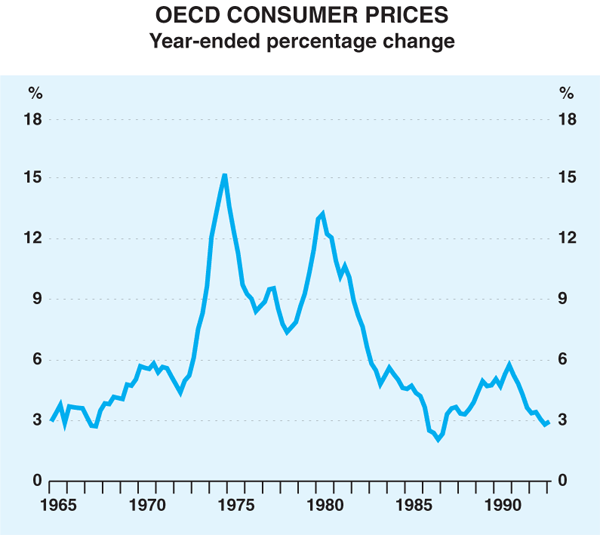
Looking ahead, it seems unlikely that we will see attempts at excessive stimulation of demand in the 1990s, or that the attempts would succeed. Fiscal policy is constrained by already large deficits and high debt to GDP ratios, so that there is no room for expansion in the vast majority of countries. All the talk is about medium-term fiscal consolidation. Monetary authorities around the world are acutely aware of the link between their policies and inflation, as are financial markets. Monetary authorities know that significant deviations from orthodoxy run the risk of being punished severely by sell-offs in the foreign exchange and bond markets. They also know the high cost that is involved in reducing inflation once it gets away; no one wants to pay that again.
This brings us to the second influence, namely supply shocks and supply influences more generally. The OPEC shocks of the 1970s were negative supply shocks – they reduced supply, or made it available at a much higher price. It seems to me that the sort of supply influences we are now facing, and will continue to face for the rest of the decade, are positive; that is, they are increasing supply, and making it available more cheaply. I think they will tend to have an ongoing restraining effect on inflation.
These supply effects could be grouped under the general rubric of globalisation and technology. They are not completely new, but for many years their effects were small. The fact that they have been at their strongest over the past few years, has caused some of their effects to be wrongly regarded as cyclical, whereas they are clearly structural. The main ones, as I see them, are as follows.
(i) Increased competition in world trade
It may well be that the major economic event of the final quarter of the twentieth century has been the rise of Asia (just as the major political event has been the collapse of the communist system). Asian countries, with their large labour forces, traditional work ethic and their capacity to benefit quickly from technology transfer, have grown at about twice the pace of non-Asian OECD countries over the past twenty years, and much of the growth has been export-led.
At first the effects on the world economy were negligible since they were growing from a small base, but as each year passed the effects became more and more significant. The intensification of international competition gradually spread to a broader and more sophisticated range of manufacturing and transport industries. As this happened, the task of producing the less sophisticated exports was handed down to lower-cost countries, and hence competitive pressure was maintained.
For the rest of the world this pressure from Asia is meaning lower import prices and intensified competition for domestic manufacturing. In many cases it has led to the demise of firms which were no longer able to remain competitive, or to those firms relocating some of their capacity to lower-cost countries. This leads on to the next, and perhaps more important aspect of globalisation.
(ii) The increased mobility of direct investment
Portfolio investment has been internationally mobile for decades; investors have bought the shares and bonds of whichever country or company they thought would provide the highest returns. Direct investment, however, has traditionally been less sensitive to comparative cost considerations.
That has all changed and now many companies, both large and small, will locate their production facilities in whichever country provides the best opportunity for them to be profitable. Obviously, such factors as tax holidays and proximity to markets are important, but the overriding consideration is the cost structure. Companies will put their production facilities where good quality factors of production (including infrastructure) are available at relatively low cost. For a lot of industries, therefore, particularly those where technology is reasonably transferable, there are a range of countries that are available as suitable and willing hosts. This situation does not apply only at the margin – that is, for additions to output – it also applies to the whole of existing production, which can also be switched. Many firms would maintain that the need to be able to relocate is not a matter of choice, but is essential to their survival.
Whatever the reason, this increased mobility is having a profound effect on management and labour. Australian line management would obviously like to continue operating in Australia, and therefore is under strong pressure to stay competitive by raising productivity and cutting costs. Their labour forces also, by and large, understand the situation. They are becoming increasingly prepared to co-operate in the search for productivity improvement, even though it often leads to labour shedding. Equally important, they know that excessive wage claims could easily lead to the departure of the production unit to another country. In this sense there has been a fundamental change in the balance of power in wage bargaining.
This process is not confined to manufacturing, but is increasingly felt in the service sector. American insurance companies that have their claims processing departments in Ireland and the Swiss airline that has its accounts department located in Bombay are classic examples. More recently, the decision of Cathay Pacific to relocate its data processing department from Hong Kong to Sydney shows that Australia can be the beneficiary as well as the loser in this process. The concept of the ‘tradeable’ sector now has to be broadened to include large areas of services, as well as manufacturing, mining and agriculture. Discussion of the service sector leads on to the third supply factor.
(ii) The rise of productivity in the service sector
Ongoing productivity gains in manufacturing, agriculture, mining, transport and telecommunications are taken for granted. Until recently, however, the ‘bread and butter’ services sector, which is by far the biggest employer, has been a laggard. Clerical functions had not yielded much in the way of productivity dividends despite the spread of computers. In addition, a lot of clerical work was carried out in the government sector, which was not subject to market pressure. Year after year employment in white collar jobs rose, even in recessions.
That is no longer the case. Management have finally found ways of exploiting the potential of the technology on offer, and productivity has risen. The most obvious sign of this has been labour shedding in the financial services sector of recent years (see later section for details). In addition, budget constraints on governments have meant that they have had to look closely at their employment levels. Their employment growth is now well below traditional rates, and in the government business enterprise sector there have been significant job losses. In a number of these enterprises, the price of the final product to the consumer has also fallen.
Implications for Australia
The world-wide trends outlined above are clearly having a large impact on Australia, and I believe their influence will be greater over the next five years than over the past five years. This influence is being widely felt and inflation is only one of the economic variables that will be affected. I will make an attempt to spell out these influences in the next section, and to address some specifically Australian problems. While we share many experiences with other countries, we also have our own special characteristics. For example, it is often said, and with a good deal of truth, that rises in inflation in Australia have always been triggered by a wage explosion or a surge in commodity prices. I accept that we are particularly vulnerable to these two events, so I will say a few words about these as well.
There has always been competitive pressure on the traded goods sector; imports could drive local products out, or those producing for exports could lose markets to other countries. As a result, firms that were losing competitiveness had to improve or close down. The pressure is greater now that tariffs are lower, and competition from Asia, including from Asian plants of American and European multi-nationals, is so much more intense. One clear indication of this is the proportion of the economy which is internationally traded. In contrast to other countries, this proportion had remained relatively constant during most of the post-war period, but since the mid 1980s, it has risen by about 40 per cent.
The biggest single change, however, is the one referred to as the increased mobility of direct investment. This has changed the environment in which economic decisions in Australia are taken. For business, it affects their approach to purchasing, investment, hiring and industrial relations. The last, in particular, is being changed in a fundamental way. Bargaining about pay and conditions now has to take into account the fact that if the plant is becoming uncompetitive it can be closed down here and reopened in a country with a lower cost structure, such as Thailand or Indonesia. Recently the union in a Melbourne food processing plant reached an agreement which conceded significant changes in conditions, partly because it knew that the alternative for the company was to shift this line of production to New Zealand. The international standard will become increasingly the norm in industrial relations.
The majority of unions probably already recognise this. The ACTU has accepted the principle that Australian wages should be determined in relation to the growth in prices and wages in our trading partners. Some scepticism has been expressed about this concession, but I have no doubt it is genuine; in fact, it is really the recognition of the inevitable. Unless changes in Australian wages, adjusted for changes in productivity, are kept in line with that of our trading partners, we lose businesses and jobs.
For this reason it is hard to see a repeat of the sort of destructive wage explosions that we had in 1974 and 1981, which contributed to both higher inflation and higher unemployment. It is widely recognised that the high level of unemployment, and the increasing flexibility provided by the spread of enterprise bargaining, are tending to hold down the growth of wages. But for the future, I think the more important influence is the one outlined above whereby the balance of power changes so that the international standard in wage bargaining becomes the norm.
Another area where these international influences are being felt is in the services sector. So far the main evidence of change is in employment, where the services sector has traditionally been the fastest growing part of the workforce. In the ten years to 1990, services employment grew by 3.4 per cent per annum, compared with 2.4 per cent for total employment. Even in recessions, white collar employment usually continued to rise reasonably strongly (Graph 2). Over the most recent cycle, however, this has not been the case; even though manufacturing employment has followed a similar pattern to the previous cycle, employment in services has been noticeably weaker.
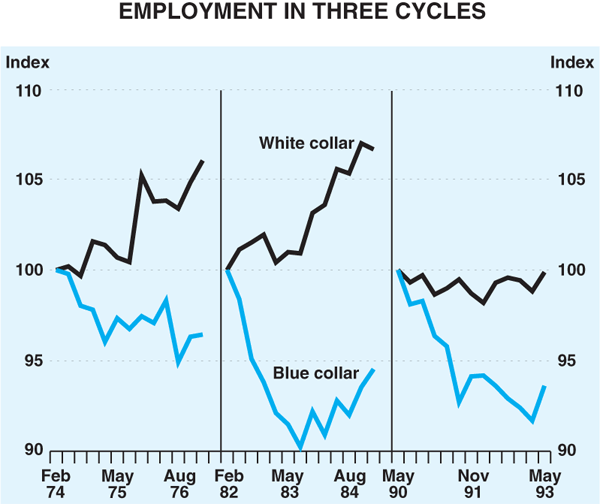
For example, employment of clerks fell by 77,000 over the past three years whereas it had risen during the 1974 to 1977 and 1982 to 1984 periods (Graph 3). Similarly, public employment has in the past risen in downturns, partly because governments pursued deliberately counter-cyclical policies. The recent cycle is the first occasion when public employment has not risen during a downturn (Graph 4).
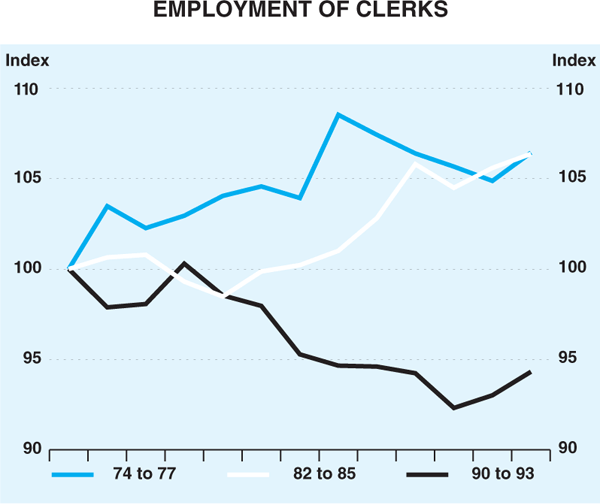
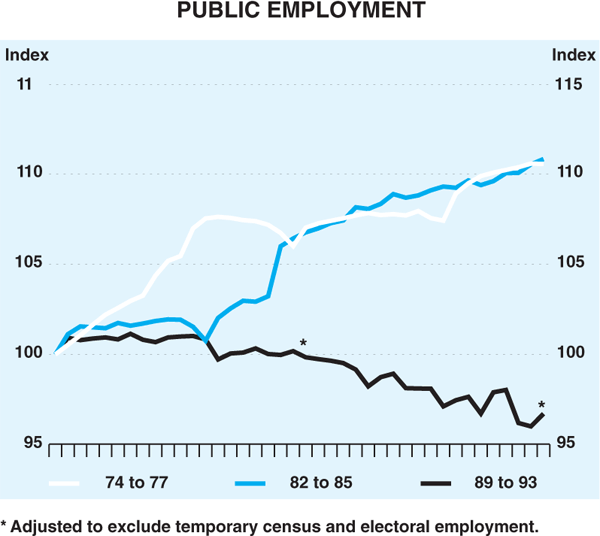
This evidence could be dismissed by saying that the present cycle has just been an unusual one. I think, however, that the international similarities suggest there is a structural change occurring, and one that is affecting virtually all countries. Technological change in services provided by the private sector, augmented in the public sector by budget constraints, is leading to a leaner services sector. In areas where there is competition, this could be expected to result in lower prices (we have already seen this in airlines and telecommunications).
In the past, the other type of shock that has triggered a rise in inflation in Australia has been a surge in commodity prices leading to a rise in the terms of trade. The two best known occasions were in the early 1950s (the Korean War boom) and in the early 1970s immediately preceding OPEC I (there was another in the late 1970s, but it is difficult to disentangle it from OPEC II). On each of these occasions, inflation rose sharply. The mechanism via which the terms of trade improvement translated into higher inflation was one that operated most potently in a fixed exchange rate system which we then had. In 1987 to 1989, however, we experienced another sharp rise in the terms of trade, and for the first time it did not lead to a rise in inflation. The main explanation for the difference was that we now have a floating exchange rate, whose appreciation helped to cushion the terms of trade effect (see Graph 5). In other words, we should no longer assume that a rise in the terms of trade, even a relatively sharp one, will lead to a rise in inflation.
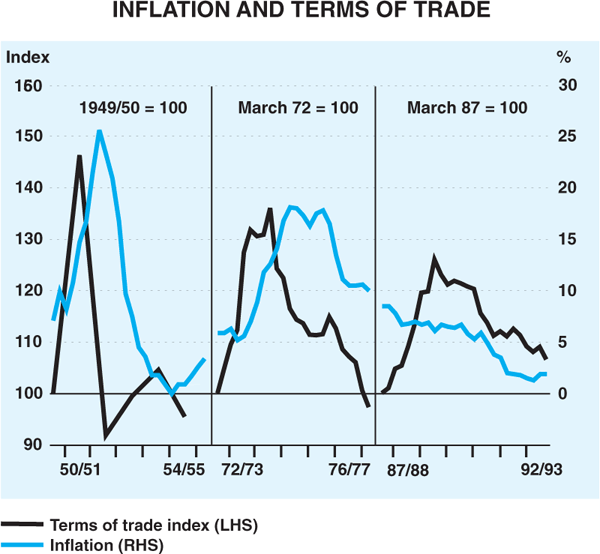
Conclusions
I hope I have not disappointed you by spending so much time at a forecasting conference talking about economic history, and some rather speculative conjectures about the next decade. For household and business investment plans, however, it is probably the next decade that matters, rather than the next year. I believe that these plans should be made on the assumption that inflation in Australia and elsewhere will be more like the 1960s than the 1970s or 1980s. Hurdle rates of return should be lowered accordingly, and there should no longer be a preference for investments that act as inflation hedges.
I do not mean to suggest by this that inflationary pressures will disappear. There will still be a need for vigilance and preparedness to act when pressures arise, as they undoubtedly will once the world economy enters a new growth phase. The task of keeping inflation down, however, is a lot less painful than the task of bringing it down after it has been entrenched. As always, monetary policy will have to play the crucial role, but in the 1990s, I believe it will have an important ally. The internationalisation of our economy, particularly the increased mobility of direct investment and the changes in attitude which these entail, will provide a discipline which will make it difficult for the growth of wages and prices to get far out of line with the international standard.
Over the past twenty years a disproportionate amount of the efforts of economists and practical policy makers has been devoted to the subject of reducing inflation. If the above conjectures about the next decade are right, more of our creative energies should be available than hitherto for other increasingly important issues. For example, how will we harness the prospective rises in productivity that technology and globalisation are producing. We know it is a source of increasing living standards, but we must translate it into increasing exports, output and most importantly increasing employment.